Welcome to a thrilling exploration of some of the most scary-looking birds on the planet. In this article, we will take a closer look at 9 bird species, some of them, like the owl, can be truly scary. that have earned their reputation as the scariest-looking birds you’ll ever encounter. From monstrous beaks to haunting gazes, these birds are sure to give you goosebumps.
Here are the main point:
- Explore 9 terrifying bird species known for their eerie appearance.
- Discover the monstrous shoebill stork, resembling a creature from a horror movie.
- Learn about the Andean condor, a massive scavenger with a wingspan of up to 10.5 feet.
- Uncover the dangerous cassowaries, large flightless birds with razor-sharp claws.
- Meet the master of camouflage, the great potoo, an expert at blending into its surroundings.
Scary Looking Birds List Incl Names with Pictures
1. Shoebill Stork
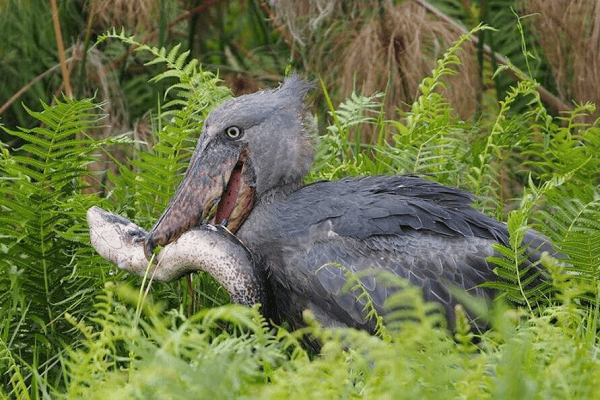
The shoebill stork is undoubtedly one of the scariest-looking birds you’ll ever encounter. With its terrifying features, it is one of the scariest-looking birds on the planet. monstrous beak and haunting gaze, this bird from the swamps of Africa resembles something straight out of a horror movie. Native to eastern tropical Africa and associated with death in Mayan culture, the shoebill can reach heights of up to five and a half feet and weigh up to 135 pounds.
The Horrifying Appearance
When you come face to face with a bird, especially if it is one of the scary birds. shoebill stork, you can’t help but feel a chill run down your spine. Its enormous beak, which is shaped like a shoe and can reach up to 9.4 inches in length, is both fascinating and terrifying. This unique feature helps the shoebill catch fish, reptiles, and even baby crocodiles with ease. Its striking resemblance to a prehistoric creature adds to its eerie aura.
A Gaze That Sends Shivers
The piercing yellow eyes of the shoebill stork mirror its fearsome nature. When those eyes lock with yours, you can’t help but feel a sense of unease. The intense stare seems to penetrate deep into your soul, leaving you feeling vulnerable in its presence. It’s no wonder that the shoebill stork has become an iconic symbol of terror.
A Look into Its Habitat
The shoebill stork is primarily found in the swamps and marshes of eastern tropical Africa. Its preferred habitats include both freshwater and alkaline lakes, as well as papyrus and grass marshes. While it may be a fearsome creature, it coexists with other diverse wildlife, including hippos, crocodiles, and various fish species.
An Avian Majesty
Despite its terrifying appearance, there is a certain majestic quality to the shoebill stork. Its grandeur is undeniable as it stands tall, with an average height of four to five feet and a wingspan of up to 9.5 feet. When this imposing bird takes flight, its grace and power are a sight to behold, even if it sends a shiver down your spine.
A Rare Encounter
Due to the declining population and the specific habitats the shoebill stork requires, spotting one in the wild is a rare and unforgettable experience. It is a testament to the beauty and wonder of the natural world, showcasing the incredible diversity of avian species.
| Key Features | Information |
|---|---|
| Scientific Name | Balaeniceps rex |
| Habitat | Swamps and marshes in eastern tropical Africa. |
| Size | Height: Up to 5.5 feet Wingspan: Up to 9.5 feet Weight: Up to 135 pounds |
| Main Prey | Fish, reptiles, and small mammals |
| Status | Near Threatened |
2. Andean Condor: A Giant Scavenger in the Sky

The Andean Condor is a massive and intimidating bird that commands the skies with its impressive wingspan. Found in the Andes mountain range, this majestic creature is often associated with death and has earned its reputation as a fearsome scavenger.
With a wingspan that can reach heights of up to 10.5 feet, the Andean Condor is one of the largest flying scary looking birds in the world. It possesses an awe-inspiring presence as it soars through the air, capturing the attention of those fortunate enough to witness its flight.
Characterized by its featherless head and distinctive plumage, the Andean Condor resembles a vulture in appearance and behavior. It possesses a keen eye for carrion, effortlessly spotting carcasses from great distances, and descending upon them to satisfy its scavenging instinct.
“The Andean Condor serves as a vital ecological role as a scavenger, cleaning up nature’s leftovers and preventing the spread of disease.” – John James Audubon
As a scavenger, the Andean Condor plays a crucial role in maintaining the balance of the Andean ecosystem. Its diet primarily consists of carrion, ensuring that no waste goes to waste. By consuming decaying flesh, the Andean Condor helps to prevent the spread of disease and contributes to the overall health of its habitat.
Despite its ominous, like a dangerous bird appearance and association with death, the Andean Condor holds a significant cultural and ecological value. It is revered by indigenous communities in the Andes and considered a symbol of power and strength.
| Features | Information |
|---|---|
| Wingspan | Up to 10.5 feet |
| Habitat | Andes mountain range |
| Diet | Scavenger (carcasses) |
| Behavior | Feeds on carrion, prevents spread of disease |
| Significance | Cultural symbol, ecological role |
3. Cassowaries: Deadly Birds of the Jungle

Cassowaries are large flightless birds that inhabit the dense forests of New Guinea and northeastern Australia. Renowned for their aggression, these scary birds have a reputation for attacking people and can deliver powerful kicks with their strong legs. With their razor-sharp claws and impressive height of up to six and a half feet, cassowaries are considered to be one of the most dangerous and intimidating birds on the planet.
Physical Characteristics
| Attribute | Cassowary | Ostrich |
|---|---|---|
| Height | Up to six and a half feet | Average of seven to nine feet |
| Weight | Up to 130 pounds | 300 pounds |
| Claws | Razor-sharp and dangerous | Powerful, but not as sharp |
| Location | New Guinea and northeastern Australia | Africa and parts of the Middle East |
These birds are truly the giants of the jungle, with their imposing size and formidable physical features. They resemble ancient dinosaurs and inspire both awe and fear in any who encounter them.
Dangerous Behavior
- The cassowary’s powerful kicks can cause serious injury, even fracturing bones.
- They are known to charge at perceived threats, showing no fear.
- Their menacing claws can cause deep gashes and puncture wounds.
- Cassowaries are fiercely territorial and will defend their territory aggressively.
While the ostrich, one of the scariest bird species known for their aggressive behavior. holds the record for being the largest bird in the world, the cassowary is often regarded as one of the deadliest. With its combination of size, strength, and aggression, encountering a cassowary in the jungles of New Guinea or northeastern Australia can be a truly terrifying experience.
4. Great Potoo: A Master of Camouflage

When it comes to nocturnal birds, the great potoo is a true master of disguise. Found in Central and South America, this enigmatic creature possesses large, wide eyes that seem to peer into the depths of the night. Its eerie call adds to its mystique, making encounters with the great potoo an otherworldly experience.
But what truly sets the great potoo apart is its remarkable ability to blend in with its surroundings during the day. With its unique plumage and cryptic behavior, this bird is a true chameleon of the avian world. Its camouflage skills are so impeccable that spotting a great potoo amidst the trees can be a spine-chilling moment.
Take a closer look at the great potoo’s camouflage prowess:
| Camouflage Features | Description |
|---|---|
| Feather Pattern | The great potoo’s feathers mimic the bark and textures of tree trunks, offering perfect camouflage against predator, similar to a dangerous bird species such as shoebills.s and unsuspecting prey. |
| Posture | When perched, the great potoo elongates its body and extends its wings, creating the illusion of a broken branch or tree stump. |
| Cryptic Coloration | Subtle variations in color and shading help the great potoo blend seamlessly with the dappled sunlight filtering through the forest canopy. |
| Stillness | Remaining perfectly still for hours at a time, the great potoo becomes virtually invisible, matching the tranquility of its surroundings. |
| Mimicking Branches is a tactic commonly used by some scary birds. | The great potoo mimics the shape and texture of branches, often adjusting its position to align with adjacent foliage. |
With its unparalleled camouflage skills and intriguing appearance, the great potoo is a true marvel of nature. Encounter this nocturnal wonder, and be captivated by its ability to disappear into the background, leaving you in awe of its disguise.
5. King Vulture: An Emblem of Death
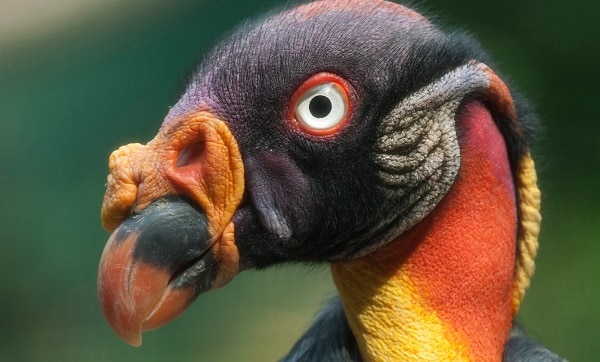
The king vulture is a truly captivating and striking bird that is often associated with death. With its vibrant colors and characteristic featherless head, this scary-looking birds creature stands out among the avian kingdoms, especially the scariest-looking birds on the planet. Found in the Americas, the king vulture possesses an eerie allure that fascinates both bird enthusiasts and those intrigued by the macabre.
One of the reasons why the king vulture is linked to death is its presence at animal carcasses. This bird has a keen sense of smell that allows it to locate carrion from great distances, making it a constant visitor to the aftermath of nature’s cycle. Just like a vulture, the king vulture’s scavenging nature serves as a reminder of the delicate balance between life and death in the natural world.
In addition to its association with death, the king vulture’s appearance is truly intimidating as it soars through the skies. Its large wingspan and powerful flight make it a dominant presence in the air, commanding attention wherever it goes. Some may even compare its aerial prowess to that of a gull, both in terms of agility and ability to cover vast distances.
King Vulture Facts
- The king vulture is known for its striking appearance, with a plumage that ranges from white to gray, yellow, and orange.
- Despite its name, the king vulture does not possess any royal lineage, but its regal appearance makes it a true monarch of the avian world.
- This bird can reach a height of 28 inches (70 cm) and has a wingspan that can measure up to 6 feet (180 cm).
- The king vulture typically feeds on carrion, using its powerful beak to tear through tough flesh and gain access to its meal.
A Visual Comparison: King Vulture vs. Gull
| King Vulture | Gull |
|---|---|
| Large bird with a wingspan of up to 6 feet (180 cm) | Medium-sized bird with a wingspan ranging from 3 to 5 feet (90 to 150 cm) |
| Featherless head and vibrant colors | Feathery head, usually in shades of white or gray |
| Associated with death due to its presence at carcasses | Not associated with death, but often seen near bodies of water like a scary bird species. |
| Powerful flight and soaring ability | Agile in flight, with the ability to swoop down and catch fish |
While the king vulture and gull may share some similarities in their flight capabilities, they have distinct differences in appearance and ecological role. The king vulture’s association with death adds an element of awe and intrigue, making it a fascinating subject of study.
6. Dracula Parrot
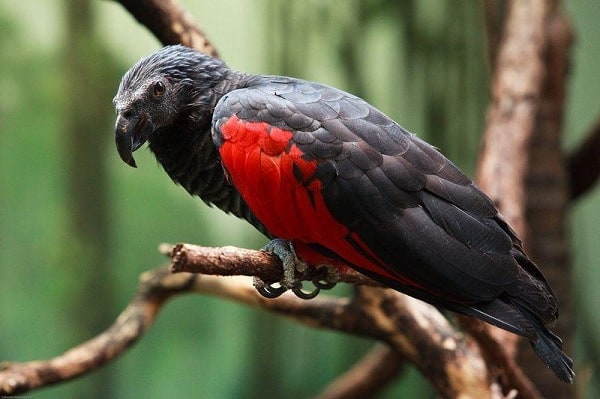
When it comes to spine-chilling bird species, the Dracula Parrot, also known as the Pesquet’s parrot, stands out with its unique and haunting appearance. Native to New Guinea, this rare parrot showcases a combination of features that make it resemble the infamous vampire from gothic legends.
The first thing that catches your attention is the parrot’s featherless head, giving it an otherworldly and eerie look. With its stark red plumage and contrasting pale face, the scary-looking birds Dracula Parrot is reminiscent of blood drops against pale skin, adding to its vampiric allure, which contributes to its reputation as a scary bird species.
The Dracula Parrot’s bright red coloration is truly eye-catching and adds to its overall creepy aesthetic. The intense red feathers bring to mind images of blood, instantly creating a sense of unease and fascination.
Despite its spooky appearance, the Dracula Parrot is a majestic bird with a wingspan of up to 130 centimeters (51 inches). This impressive wingspan allows it to gracefully navigate the dense forests of New Guinea, making it a true sight to behold.
If you’re an avian enthusiast with a taste for the unusual and creepy, the Dracula Parrot is a must-see bird species. Its haunting beauty and unique features make it a captivating addition to the world of ornithology.
7. Raven and The Crow:
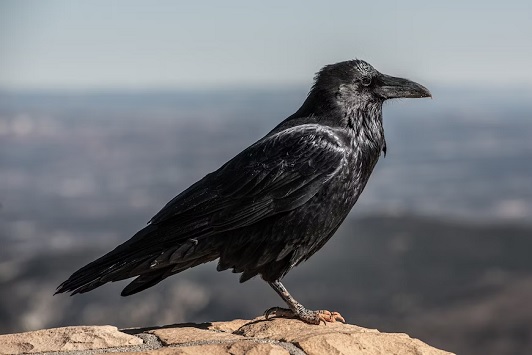
Ravens and crows are often associated with spooky and macabre imagery, making them perfect additions to this list. With their dark feathers, unsettling caws, and their reputation as messengers of misfortune, these intelligent birds have long been depicted as symbols of darkness and mystery.
8. Marabou Stork

The marabou stork is a large and grotesque bird found in Africa. With its featherless head and gruesome appearance, this bird is a true monstrosity. Feeding on carrion and even baby crocodiles, the marabou stork is undeniably one of the scariest-looking birds in existence.
9. Ostrich
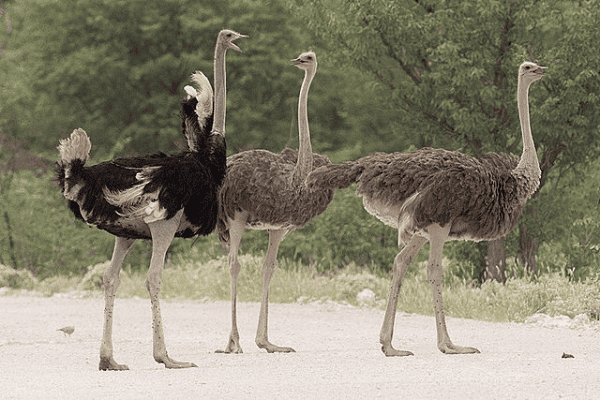
Although not conventionally terrifying in appearance, the ostrich earns its spot on this list due to its immense size and incredible speed. Weighing in at up to 300 pounds and standing over 9 feet tall, this gigantic bird can strike awe and fear into the hearts of those who encounter it.
But it’s not just its size that makes the ostrich remarkable. This impressive creature is also the scariest bird you could encounter. largest bird in the world, towering above all others in the avian kingdom. With long, powerful legs and a distinctive long neck, the ostrich is truly a sight to behold.
What sets the ostrich apart from other birds is its exceptional swift speed. These flightless giants are built for incredible locomotion, capable of reaching speeds of up to 60 miles an hour. Whether on the African savannah or evading predators, the ostrich’s ability to sprint with such agility is truly breathtaking.
“The ostrich’s immense size and lightning-fast speed make it a force to be reckoned with in the bird world.” – Bird Enthusiast Magazine
This remarkable bird not only commands attention but also exemplifies the wonders of the animal kingdom. The ostrich’s unique combination of size, speed, and beauty is a testament to the diversity and majesty of our natural world.
10. Shrike: A Tiny Scary Looking Birds with a Deadly Habit
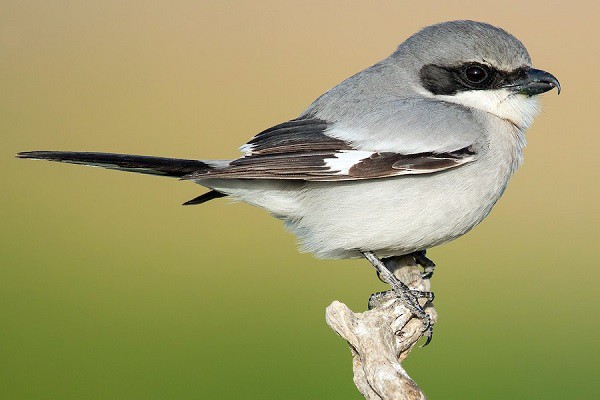
Despite its small size, the shrike is a formidable predator known for its gruesome feeding habits. This bird is a true embodiment of the saying “fear can come in the smallest of packages.” With its swift and deadly strikes, the shrike leaves a trail of decapitated and disemboweled prey in its wake.
The shrike’s hunting technique is as unique as it is terrifying. It impales its unsuspecting victims, which can include insects, small birds, and even small mammals, on thorns or barbed wire, much like a dangerous bird. This macabre behavior has earned the shrike the chilling nickname “butcher bird.” The impaled prey not only serves as a storehouse of nutrition, but also acts as a macabre display to potential rivals, warning them of its predator prowess.
“The shrike is a master of precision and efficiency when it comes to hunting. Its method of impaling prey on sharp objects is not only an effective way to kill, but also serves as a means of preserving its food for later consumption. It’s a truly fascinating and horrifying sight to witness.”
Although the shrike’s beak may be small, it possesses a sharp hook at the tip that allows it to swiftly incapacitate its prey. This tiny bird is a true embodiment of nature’s ferocity, as it uses its lethal combination of agility and predatory instincts to thrive in its ecosystem.
Shrike Predation Techniques
The shrike employs a variety of predatory techniques, showcasing its adaptability as a hunter. Some of these techniques include:
- Impaling prey on thorns, barbed wire, or sharp branches for consumption later
- Aerial acrobatics to catch insects in mid-air
- Ambushing prey from perches
The shrike’s unique hunting methods set it apart from other birds and make it an intriguing species to study and observe. Its small size belies its deadly capabilities, serving as a reminder that predators can come in all shapes and sizes.
| Predator | Prey | Location | Impalement Method |
|---|---|---|---|
| Shrike | Insects | Throughout the world | Impales them on thorns or sharp branches |
| Shrike | Small birds | Various habitats | Impales them on thorns or barbed wire |
| Shrike | Small mammals | Diverse ecosystems | Impales them on thorns or sharp branches |
Final Thoughts:
In conclusion, the world of avian creatures is not just full of beauty and grace but also holds some of the most terrifying and intimidating species. From the monstrous beak of the shoebill to the eerie appearance of the Dracula Parrot, these birds are sure to send shivers down your spine. Whether they’re associated with death, have deadly habits, or simply possess an uncanny appearance, these 9 scary-looking birds add intrigue and fascination to the avian world. Explore them if you dare!
